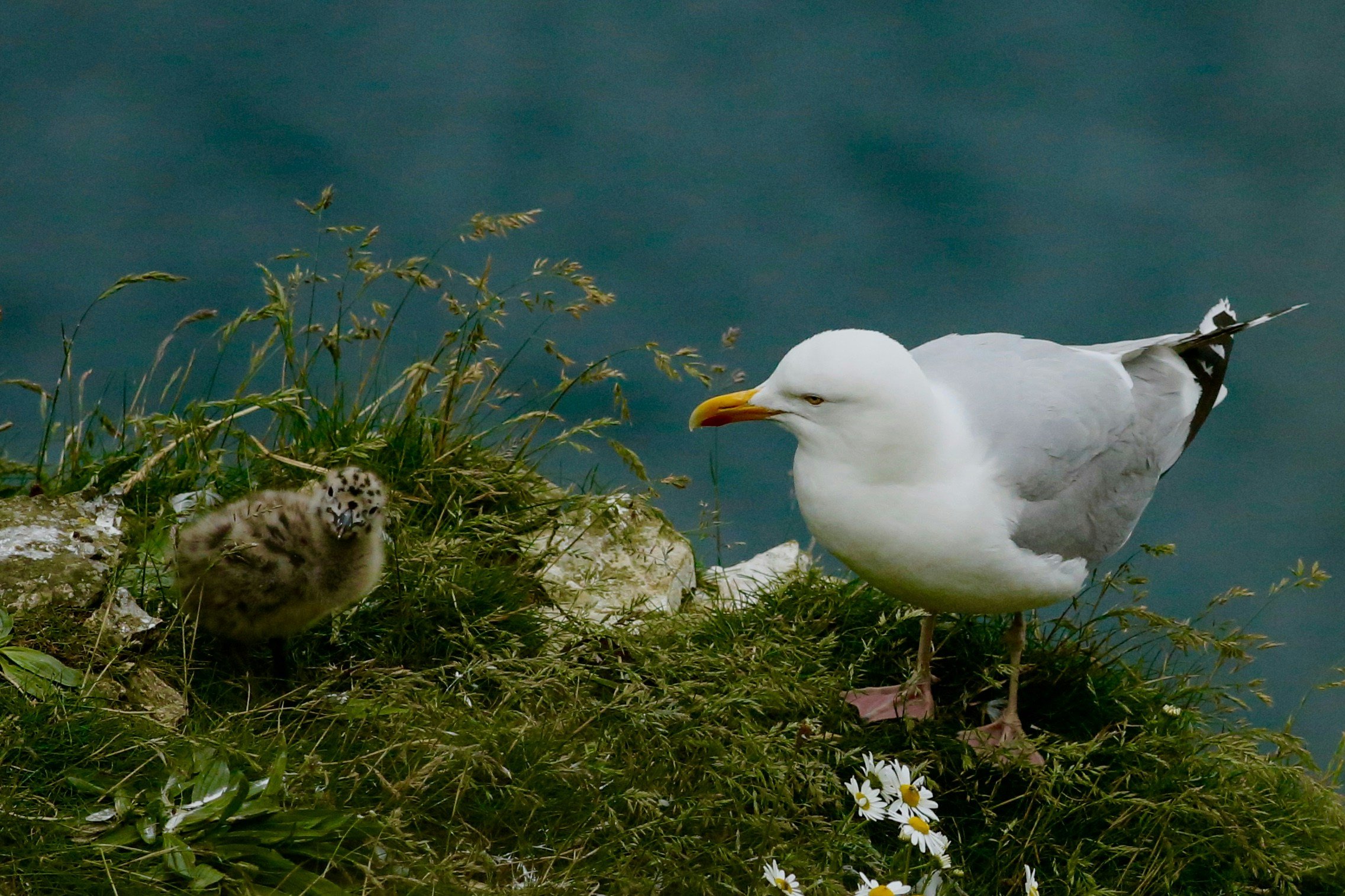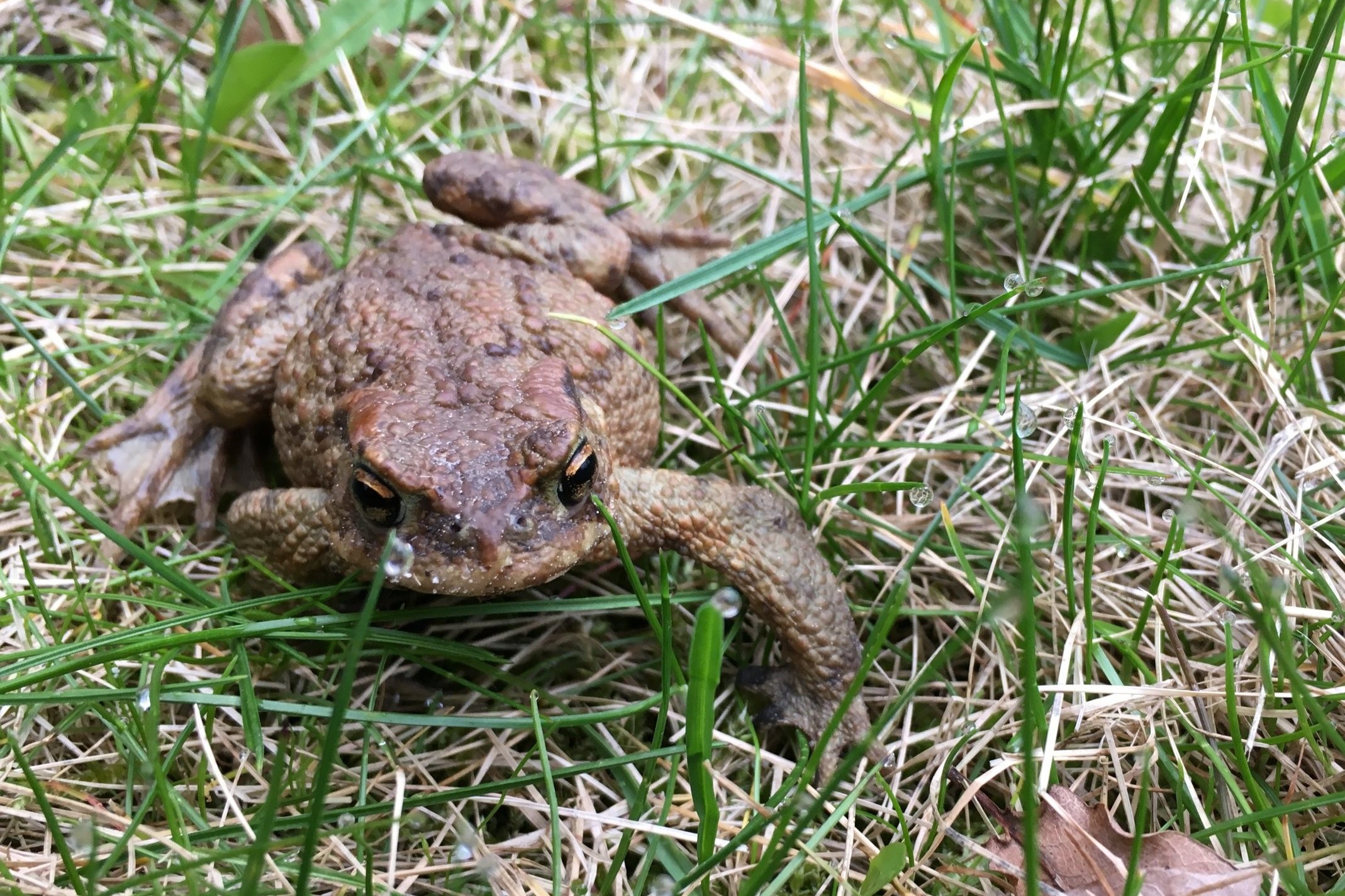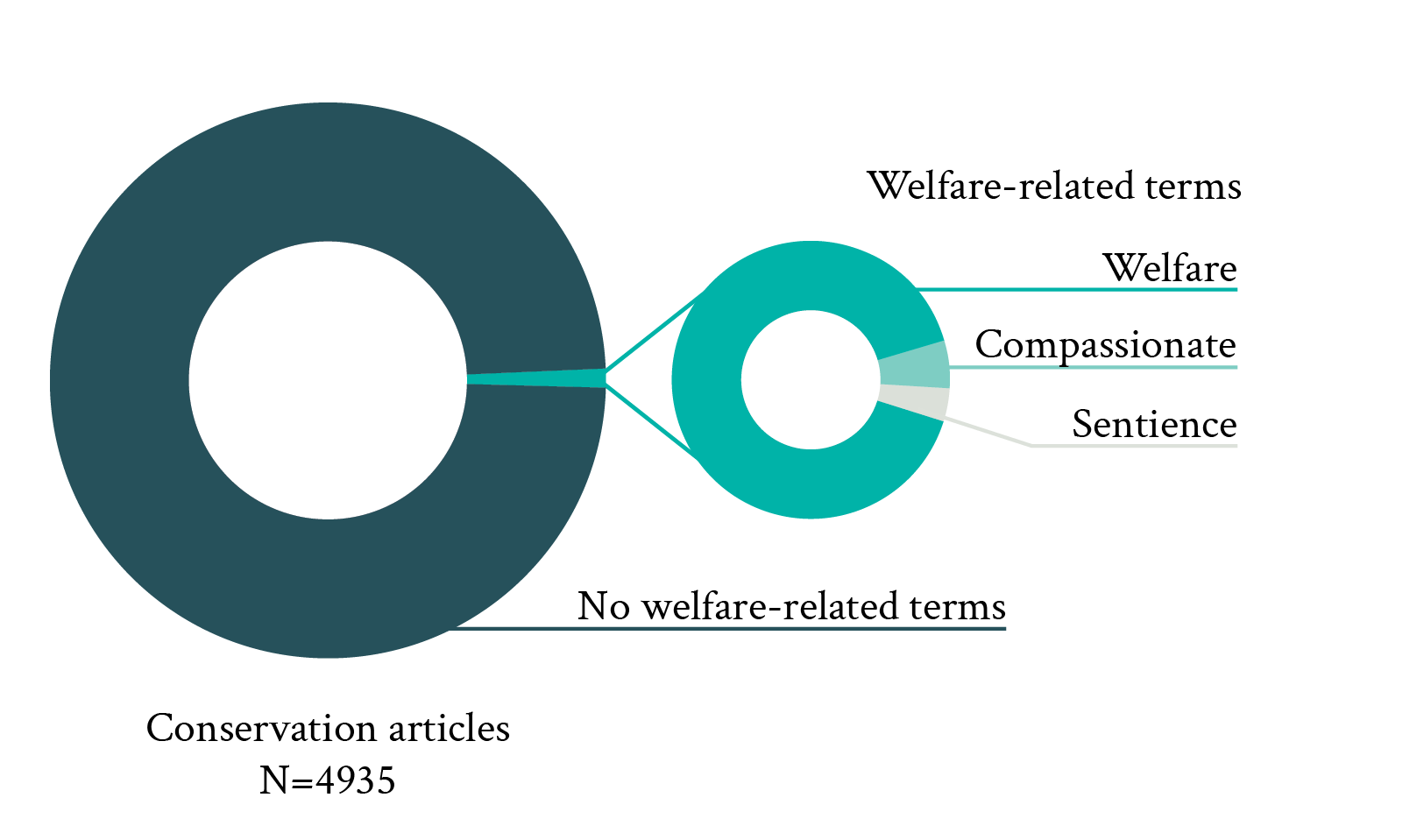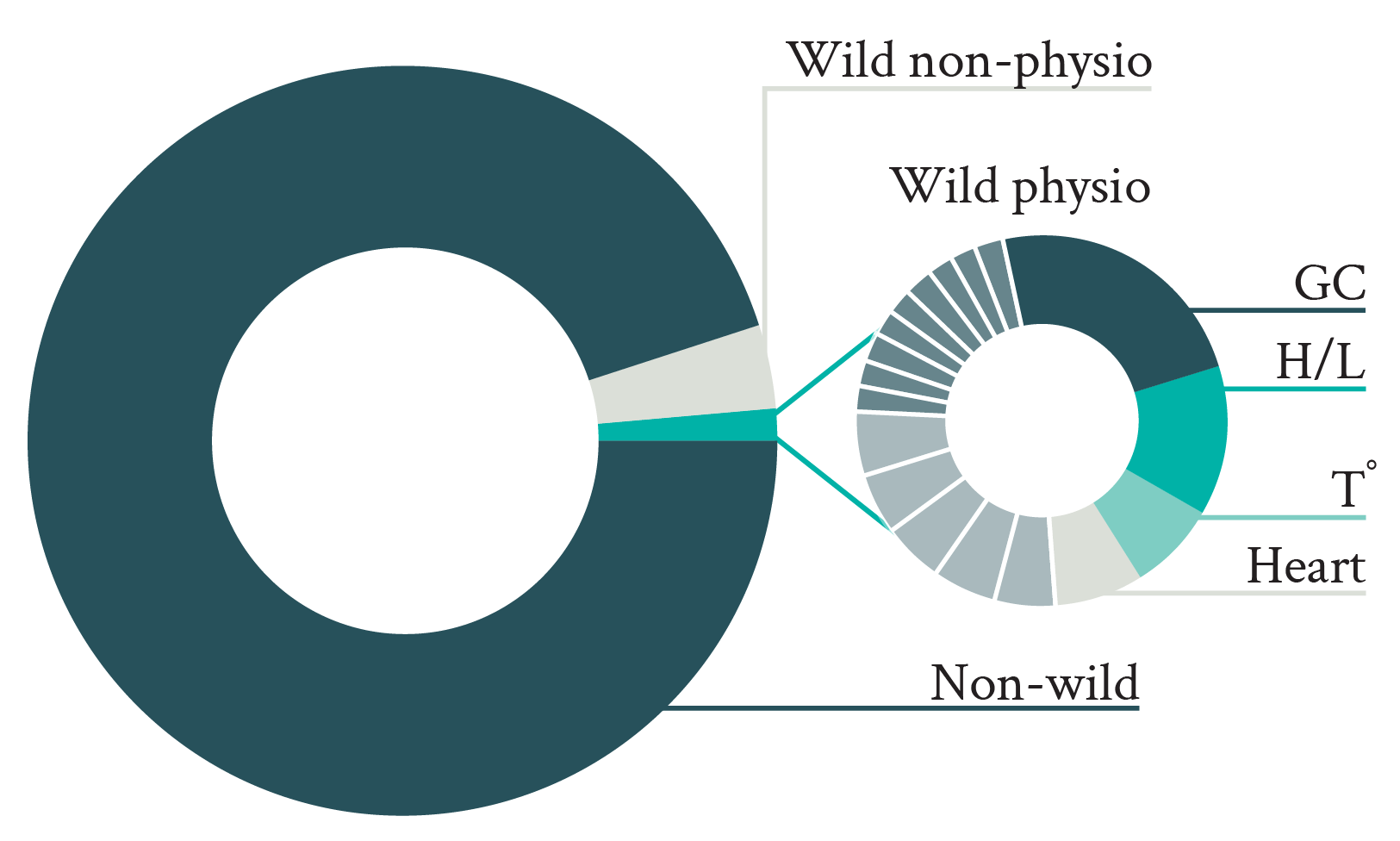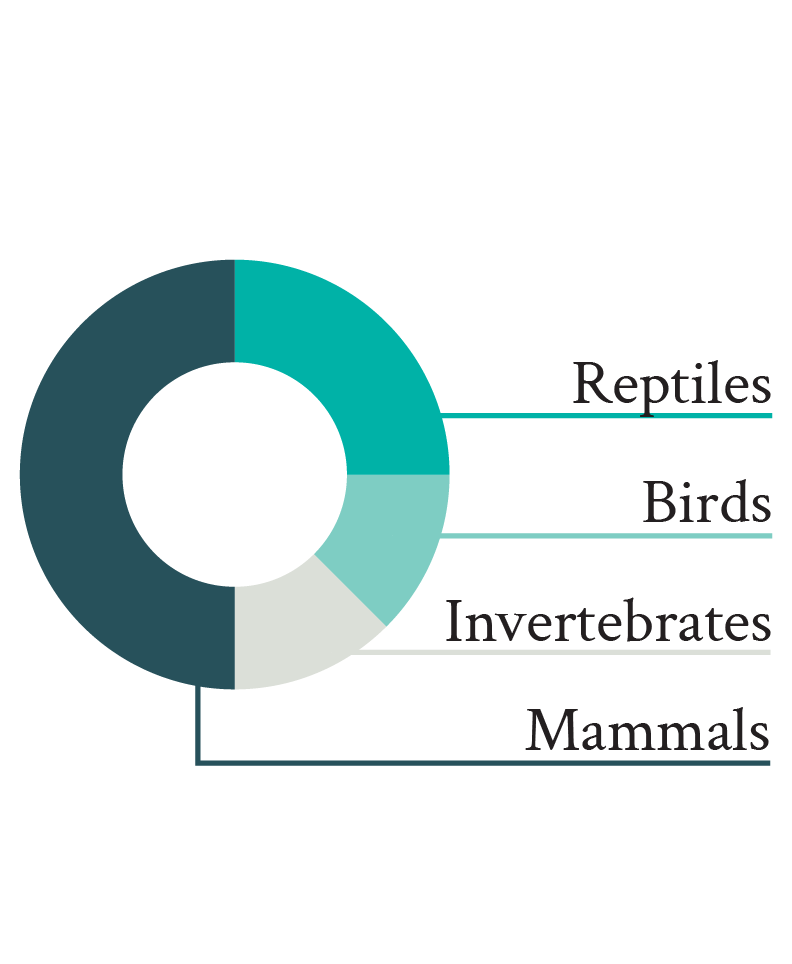
Library
Browse resources published by our research team.
In addition to full texts of our peer-reviewed articles, our library includes research digests that break down our peer-reviewed articles; in-depth reports that thoroughly examine a topic; commentaries that explain the significance of particular issues in wild animal welfare science; and short communications that briefly survey a field or topic.
Wild Animal Initiative adheres to Open Science TOP Guidelines. Read more here.
Rehabilitating wild animal welfare: A focus on veterinary rescue and rehabilitation interventions
Beaulieu, M. (2025). Rehabilitating wild animal welfare: A focus on veterinary rescue and rehabilitation interventions. Research in Veterinary Science, https://doi.org/10.1016/j.rvsc.2025.105582
Authored by Wild Animal Initiative’s Research Manager, Michaël Beaulieu, this paper was published in the April 2025 issue of Research in Veterinary Science.
Abstract
Conservation considerations are often put forward to justify wildlife veterinary interventions.
Paradoxically, the conservation impact of such interventions is often uncertain.
These interventions, however, have a clear impact on the welfare of wild animals.
This confusion is likely related to the connection between animal conservation and welfare.
Veterinarians need to explicitly recognize the welfare value of their interventions on wildlife.
Quantifying the neglectedness of wild animal welfare
Michaël Beaulieu's deep dive examines the quality and quantity of mentions of wild animal welfare in the scientific literature and finds it to be a neglected research area.
Written by: Michaël Beaulieu
Published: November 22, 2023
DOI: https://doi.org/10.71441/7vws-rn93
Suggested citation: Beaulieu, M. (November 2023), Quantifying the neglectedness of wild animal welfare, Wild Animal Initiative, retrieved [date], https://doi.org/10.71441/7vws-rn93
Questioning the neglectedness of wild animal welfare: passionate claims, illusionary facts, or simple truth?
Wild animal welfare is often suggested to be a neglected research area, worthy of more attention from scientists and policy makers (e.g., Tomasik 2015; Forristal 2022). Considering the general propensity of animal welfare to unleash passions even among scientists (Coghlan & Cardilini 2022), it is important to assess the veracity of these claims. So to objectively assert the need to conduct more research to better understand wild animal welfare and implement sound welfare interventions in the wild, clear evidence (or “stubborn facts” insensitive to people’s inclinations and passions; Adams 1770) supporting the neglectedness of wild animal welfare is required.
Cursory research of the expression “wild animal welfare” in Google Scholar (Nov. 2023) provides 844 outputs, only 7% of which emphasize the expression in their title or abstract. However, such figures may be misleading if wild animal welfare is already considered under alternative synonyms or already incorporated into adjacent disciplines. For instance, the fate of wild animals in response to variable environmental conditions has traditionally been under the scrutiny of conservation practitioners (Brown 2007; Nijhuis 2020). Because conservation studies typically focus on conditions that affect animals in their natural habitat (for instance, environmental conditions changing because of anthropogenic activities and that may be perceived as unpleasant by wild animals), they may theoretically also encompass aspects related to wild animal welfare (Sekar & Shiller 2020). Therefore it is possible wild animal welfare is not so highly neglected, but rather often concealed within existing animal conservation studies. Importantly, because the multidisciplinary field of wild animal welfare includes a variety of approaches, indicators, and taxa, some research areas within this field may be more neglected than others.
Assessing the neglectedness of wild animal welfare
To assess the neglectedness of wild animal welfare, I have conducted a targeted review of the literature in peer-reviewed journals publishing research in animal welfare (three journals: Animal Welfare, Journal of Applied Animal Welfare Science, animal welfare section of Animals) and animal conservation (five journals: Animal Conservation, Biological Conservation, Conservation Biology, Conservation Physiology, Oryx). I selected these journals because of their high visibility and their representativeness in their respective field. I considered a date range of 2013-2022 for the review process, in order to reflect contemporary research on animals. Accordingly, I only included research articles (as opposed to reviews, commentaries) focusing on animals (as opposed to, e.g., plants, policy) in the review of both fields. I identified and classified the study subjects of each welfare science article as “wild” if they were studied in their natural habitat or collected in the wild and then studied in captivity. In conservation articles, I searched for welfare-related terms (e.g., welfare/wellbeing, sentience, emotion, conscious, subjective experience, affective state, compassionate) in both the title and abstract.
Confirming the neglectedness of wild animal welfare
Both the presence of wild animals among all reviewed welfare studies (6%) and the occurrence of welfare-related terms in conservation studies (1%) were very low (Fig. 1). Among welfare-related terms, “welfare/wellbeing” was by far the most commonly used term (90%) in conservation journals. In addition to “welfare/wellbeing,” other welfare-related terms such as “compassionate” (6%) and “sentience” (4%) were also found. However, other welfare-relevant terms such as “conscious,” “subjective experience,” or “affective state” were completely absent. Altogether, these proportions strongly suggest that wild animal welfare is neglected by both the welfare and conservation literature.
Figure 1. Proportion of articles published in three principal animal welfare journals between 2013 and 2022 and including wild animals (left pie, top on mobile), and proportion of articles published in five principle conservation journals over the same period and including welfare-related terms in either their title or abstract (welfare, compassionate and sentience were the only terms found; right panel, bottom on mobile).
Dissecting the neglectedness of wild animal welfare: the example of physiological approaches
To understand how an animal experiences their life in the wild, it is necessary to use approaches that can evaluate and provide evidence of their welfare. Behavioral and physiological markers potentially represent downstream indicators of welfare, and can thus provide insight into the welfare of wild animals (Browning 2022). I focused here on physiological markers specifically, as they may be highly informative (on their own or to complement behavioral approaches) for assessing the welfare of wild animals (see deep dive: Welfare and physiology: a complicated relationship). To quantify the degree to which physiological approaches are also being neglected in wild animal welfare science, I have further examined the welfare science studies previously identified as being conducted on wild animals to determine whether they made use of physiological markers and in which species.
Only 22% of welfare science studies conducted on wild animals included the use of physiological markers (Fig. 2). These results suggest that wildlife biologists either are reluctant to make use of physiological markers in their research relative to other welfare indicators (e.g., living conditions, behavior), or they lack awareness of how to incorporate them. Yet the very existence of the field of conservation physiology, and the numerous studies published, demonstrate that it is possible to measure a diversity of physiological markers in the wild to examine how wild animals are affected by given environmental conditions (Cooke et al. 2013). Nevertheless, despite this potential, thus far such studies have not focused on assessing welfare, as indicated by only 3% of articles published in conservation journals and including physiological parameters mentioning welfare-related terms in their title or abstract. Moreover, the few studies that considered physiological parameters to assess welfare in wild animals focused on a limited number of physiological markers (compared to the vast variety of physiological parameters that could theoretically be measured to assess welfare; e.g., Jerez-Cepa & Ruiz-Jarabo 2021; Whitehead & Dunphy 2022) measured in few taxa, the typical study measuring glucocorticoids in a mammal species (Fig. 2).
Figure 2. Proportion of articles published in three principal animal welfare journals between 2013 and 2022 and including wild animals (left pie, top on mobile) and measuring physiological markers (striped area). The detail of the measured physiological markers (GC: glucocorticoids; H/L: heterophil/lymphocyte ratio, Tº: temperature) and in which taxa (Invert.: invertebrates) they were measured is illustrated in the right pies (bottom on mobile). For clarity, only the first half of the physiological markers measured in articles on wild animal welfare physiology is annotated.
The overrepresentation of glucocorticoids (and their effects on the H/L ratio; Davis et al. 2008) and mammals among studies on the physiology of wild animals is not necessarily surprising, but their measurement is questionable when examining their welfare. Indeed, even though measuring glucocorticoids reflects a general trend observed in animal stress physiology (MacDougall-Shackleton et al. 2019), the relationship between glucocorticoids and welfare remains unclear (Ralph 2016). Therefore, for glucocorticoid measurements to offer useful insights about welfare, they need to be complemented by additional markers (e.g., behavioral observations). Moreover, even though the imbalance in favor of mammals probably reflects the widespread greater interest in these animals, mammals are relatively rare in nature (ca. 0.1% of all animal species and ca. 0.35% of the whole animal biomass on Earth; Mora et al. 2011; Burgin et al. 2018; Bar-On et al. 2018), and the way they experience their lives is probably not comparable to that of other taxa with very different neural organizations (e.g., more common invertebrates; Paul et al. 2020).
Conclusions
Review of recent literature in key peer-reviewed journals in animal welfare showed that the neglectedness of wild animal welfare is indeed a “stubborn fact” and not just a questionable claim. Importantly, the targeted review of journals in animal conservation also provided evidence that this underrepresentation was not simply an artifact of the inclusion of welfare aspects within animal conservation studies (that were found to refer to animal welfare only anecdotally and superficially). Moreover, within the limited number of studies that did focus on wild animal welfare, the limited use of physiological markers further highlights the neglectedness of valuable methodological approaches and taxa. If allowed to persist, such biases will likely limit our understanding of wild animal welfare, as the strength of this field precisely lies in its diversity of approaches and the range of taxa to which they can be applied. Continuing not to take advantage of such potential would be short-sighted.
The limited availability of welfare science studies focusing on wild animals suggests that there may be resistance or barriers to extending the scope of welfare science beyond the traditional context of farmed, companion, and captive-housed animals. A contributing factor may be that assessing welfare is easier in well-known model species maintained under controlled conditions in captivity (e.g., pigs), compared with their wild counterparts living under uncontrollable conditions (e.g., wild boars). Another contributing factor might also be related to the uncertainty about the capacity of many wild animals to have subjective experiences (e.g., invertebrates, but see Anderson & Adolphs 2014; de Waal & Andrews 2022). Despite these inherent challenges, there is increasing evidence that extending the field of animal welfare to wild conditions is feasible (Harvey et al. 2020), particularly through collaborations among scientists from a range of disciplines, and could have far-reaching impacts for our general understanding of how most animals on Earth experience their lives. In addition to advancing general understanding and increasing available knowledge, wild animal welfare studies may also lead to concrete applications — for instance, by informing stakeholders, refining practices, or modifying legislation impacting wildlife. But the full potential of the field of wild animal welfare will be reached only if scientists branch out beyond traditional norms and consider the full range of approaches and taxa that this field has to offer.
What is the value of wild animal welfare for restoration ecology?
Jane F. Capozzelli, Luke Hecht, Samniqueka Halsey
Capozzelli, J. F., Hecht, L., & Halsey, S. (2020). What is the value of wild animal welfare for restoration ecology? Restoration Ecology, https://doi.org/10.1111/rec.13114
Authored by former Wild Animal Initiative Staff Researcher Jane Capozzelli, Wild Animal Initiative Science Director Luke Hecht, and Samniqueka Halsey, Assistant Professor in the College of Agriculture, Food and Natural Resources at the University of Missouri, this paper was published in March 2020 in Restoration Ecology.
Abstract
The restoration community continues to discuss what constitutes good environmental stewardship. One area of tension is the extent to which the well-being of wild animals should inform restoration efforts. We discuss three ways that the perspective of wild animal welfare can augment restoration ecology: strengthening people's relationship with nature, reinforcing biotic integrity, and reducing mechanistic uncertainty. The animal welfare movement elevates sentient animals as stakeholders and explores how environmental context directly impacts the well-being of individuals. Viewing wild animals through this lens may encourage people to think and act with empathy and altruism. Second, we incorporate animal welfare into the concept of biotic integrity for ecological and ethical reasons. Restoring ecosystem processes may enhance animal welfare, and vice versa. Alternatively, there may be a trade-off between these factors, requiring local decision-makers to prioritize between restoring ecosystem function and promoting individuals' well-being. We conclude by discussing how welfare can impact population recovery, thereby adding insights about mechanisms underpinning restoration objectives. Ultimately, restoration ecologists and proponents of wild animal welfare could enjoy a productive union.
Summary of “What is the value of wild animal welfare for restoration ecology?”
Jane Capozzelli, Luke Hecht, Dr. Samniqueka Halsey
This post summarizes a 2020 perspective piece by Jane Capozzelli, Luke Hecht, and collaborator Samniqueka Halsey, in which they explore the potential for synergy between restoration ecology and wild animal welfare research.
Written by: Jane Capozzelli, Luke Hecht, Samniqueka Halsey
Published: March 2, 2020
DOI: https://doi.org/10.71441/fcr9-4ecj
Suggested citation: Capozzelli, J., Hecht, L. and Halsey, S. (March 2020), Summary of “What is the Value of Wild Animal Welfare for Restoration Ecology?” Wild Animal Initiative, retrieved [date], https://doi.org/10.71441/fcr9-4ecj
This piece was published in the March 2020 issue of Restoration Ecology.
Why discuss wild animal welfare in restoration ecology?
Research and outreach disrupts status quo narratives, such as the perception that wild animal welfare and environmental management must operate under mutually-exclusive values, metrics, or models. Writing peer-reviewed articles in environmental science journals builds a common academic language to address environmental problems. It also catalyzes interdisciplinary thinking by considering pluralistic, alternative ethics of environmental stewardship. These two steps both bring us closer to generating solutions for improving the lives of wild animals.
Our overall thinking is that proponents of wild animal welfare and restoration ecology share, to some extent, a non-anthropocentric worldview and a desire to collaborate to help wild animals. Yet the virtues and consequences of “respect and responsibility for wild animals” are viewed through a different lens by ecologists and proponents of wild animal welfare.
The research in a nutshell
To build common ground toward solutions for improving the lives of wild animals, we provided a window into the animal welfare community for restoration ecologists, particularly wild animal welfare’s ethical positions and research priorities. We also acknowledged that people may differentially prioritize welfare- and conservation-oriented objectives. Yet, wild animal welfare is relevant, regardless, because of the instrumental value of providing for the needs of individual animals.
To further frame our argument around animal ethics and morality, we blended our instrumental arguments around the moral foundations of conservation ethics, established in Aldo Leopold’s land ethic. We highlighted that the land ethic includes moral concern for individual, “fellow-members” of the landscape. Despite the value the land ethic places on animals, the management community has not resolved how to support individual animals while maintaining their ecosystem. It also does not sufficiently account for diverse ethical perspectives regarding what constitutes good environmental stewardship, nor take advantage of the information-value of animal welfare, as animal well-being depends on a host of behavioral, physiological, and environmental factors.
Key takeaways
Our manuscript illustrates three ways that the perspective of wild animal welfare augments restoration ecology.
Strengthening relationships between people and nonhuman animals. Restoration ecology could engage with wild animal welfare to advance a human-nature relationship infused with empathy and altruism.
Supporting multidimensional ecosystem health. It is possible to simultaneously improve ecosystem function and animals’ well-being. Synergistic interventions would concurrently support individuals and ecosystems, with the added benefit of encompassing multiple ethical and moral stances regarding what is good environmental stewardship.
Reducing uncertainty about interventions. Several aspects of animal welfare, such as health, physiology, behavior, and cognition, can modify species, communities, and ecosystems. A greater understanding of these relationships can reduce uncertainty regarding the outcomes of interventions for wildlife collectives or individuals.
Next steps
An essential challenge ties together proponents of environmental management and wild animal welfare: resolving ethical and ecological conflicts on an increasingly complex and interconnected planet. The challenge for the wild animal welfare movement is to illustrate the ways that wild animal welfare is important and viable. Future work on these topics continues at Wild Animal Initiative to reorient animal advocacy and environmental science with a view of wild animals as morally-relevant subjects, who are entitled to a good life, and to catalyze evidence-based solutions for modern environmental problems on behalf of wild animals.

